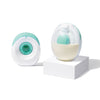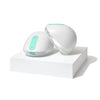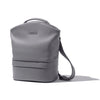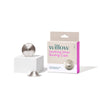A step-by-step guide to securing the right breast pump through your insurance coverage.
If you’re looking for a breast pump covered through insurance, you’re in good company. Thanks to the Affordable Care Act (ACA), most health insurance plans are required to cover breast pumps — and that includes wearables! Your plan may have guidelines on whether the covered pump is manual or electric, rental or personal, the length of the rental, and when you’ll receive it (before or after birth). And though matters of insurance can sometimes be complicated, this process is, thankfully, pretty straightforward.
In this article, we’ll cover all things related to insurance-covered breast pumps, such as:
- Types of breast pumps covered
- Step-by-step process
- Upgrade opportunities
- Which Willow products are covered
- And more!
What Does Insurance Cover for Breast Pumps?
There are three different types of breast pumps covered by insurance: manual, electric, and wearable pumps. Here’s the difference:
A manual breast pump, sometimes called a “hand pump,” is a non-electric device in which milk expression is controlled exclusively by you. These can be quite laborious, but could be a good option for wearing on one breast while nursing on the other or using in a pinch if your go-to pump is out of commission for any reason.
An electric breast pump, also referred to as a “traditional pump” or “wall pump,” provides constant and steady pumping through a motor, and requires charging from an electric outlet. Though they may have a stronger suction than manual breast pumps or those operated by battery, they still tether you to tubing and equipment. Even portable options require a motor to be carried while pumping, which can be cumbersome on the go. Typically, these pumps alternate between suction and release functionality, which is most traditional, but will feel different than breastfeeding your baby.
A wearable pump offers a hands-free experience that allows mom to pump without being plugged into the wall. These electric, battery-powered pumps can vary quite a bit — some are fully in-bra and some aren't, some are app-controlled and some aren't — but they all offer more mobility, convenience, and freedom than their traditional counterparts. Willow offers two different wearables: Willow Go, engineered for optimal comfort and milk output with a suction pattern that mimics nursing, and Willow 360, the only pump that's 100% leak-proof in any position for ultimate mobility.
Learn more about how to pick the right breast pump for you.
In addition to the variety of breast pumps covered by your plan, certain accessories like milk storage bags, flanges, and spare parts may be covered by insurance as well. To see which Willow products are covered by your insurance, you’ll need a signed prescription from your OB/GYN, your insurance card and information, and your OB/GYN’s contact information.
Step-by-Step Guide to Getting a Breast Pump Through Insurance
Step 1: Check Your Insurance Plan
The very first step in understanding which breast pumps and supplies are covered by your insurance is to contact your provider and ask a few questions:
- Does my plan cover the purchase or rental of a breast pump?
- What type of pump is covered (manual, single electric, double electric)?
- Are there any limitations on the number of pumps I can get per pregnancy or in a lifetime?
- Are there specific brands or models covered?
- Do I need a doctor's prescription to get a breast pump? If so, where should it be sent?
- Does my plan require a copay or that I meet a deductible?
- How long can I rent a hospital-grade pump if needed?
- Can I order the pump before my baby is born?
Note that some pumps are covered only partially, requiring you to pay the difference if you wish to “upgrade.” This is a great place to use FSA/HSA funds if you have them! (Learn more about using your FSA/HSA funds to buy a pump or pumping accessories here.)
Step 2: Obtain a Prescription
A breast pump is a medical device, so most insurance providers will require a prescription for the cost to be covered. This can also apply to supporting items like compression socks and postpartum garments. Whether you’re still pregnant or postpartum, be sure to talk with your doctor about your needs. Things to consider when you’re choosing a breast pump are:
- Will you be returning to work?
- Does your job require you to be on your feet or on the go for most of the day?
- Will you be caretaking for anyone else such as another child or parent?
These factors may influence which pump will help you maximize your breastfeeding goals. If your child was born prematurely or has difficulty nursing due to a medical condition, these are important topics to discuss with your doctor, who can help you devise a pumping plan that works for you and your baby.
Step 3: Choose an Approved Supplier
Most insurance companies work with different DME (durable medical equipment) providers such as Pumps for Moms, Aeroflow, and others, to source breast pumps. Your insurance provider will be able to direct you to an approved site. Some DMEs, like Insurance Covered Breast Pumps, will even obtain your prescription from your OB/GYN, contact your insurance, and fill out the claim for you.
Once your insurance company has directed you to their approved DME provider, reach out as soon as possible. You can search for a variety of pumps. Though you will qualify for a breast pump through insurance at any time during your pregnancy, and up to one year postpartum, there may be an approved timeframe in which you may receive your pump. Sometimes, DMEs are required to wait until at least 30 days prior to your due date to ship your breast pump. It’s best to go ahead and secure your pump of preference. It will be shipped as soon as you are within the approved timeline to receive it.
Lastly, give yourself plenty of time to explore your options. If you’re a first-time mom, finding the right breast pump for your needs and lifestyle can feel overwhelming. Take a breath, you’re doing great.
Step 4: Place Your Order
Once you’ve chosen your breast pump, follow the prompts on your insurance provider’s approved DME website. They will verify your insurance, usually within 24 hours of receiving your order and accompanying prescription. Then your pump will be shipped according to your insurance guidelines, usually within 1–5 days after verification and processing.
Tips for Choosing the Right Pump
There are multiple factors to consider when choosing a breast pump, such as portability, efficiency, and features. Many moms opt for a hands-free, wearable pump like the Willow Go because it allows for all-day freedom, comfort, and maximum output.
It’s clinically tested and officially a mom favorite, with 9 out of 10 moms saying it’s just as, if not more, comfortable than their traditional pump, and 8 out of 10 moms saying the Willow Go is more comfortable than other wearable pumps. See what moms are saying about the Willow Go.
The Willow 360 is the only pump that’s 100% leak-proof in any position, the only pump that’s compatible with self-sealing milk bags or reusable containers, the only pump that’s app-controlled from phone or Apple Watch, and the only pump that’s supported by personalized US-based customer care. It’s a fan favorite among teachers, doctors, nurses, first responders, and others who work long shifts outside of the home. Learn more about what makes Willow 360 different.
Both the Willow Go and Willow 360 are easily controlled by an app. In addition to portability, efficiency, and features, they offer a few additional
- Inclusive flange sizing: Willow pumps come in multiple flange sizes and are compatible with silicone sizing inserts for a more custom-feeling, comfortable fit (and improved output in turm)
- Flange tunnel: Willow breast pumps have longer, smoother flange tunnels than most wearables for greater comfort.
- Flange design: Curved, comfort-promoting edges wrap back around the pump instead of a flat, cone-shaped edge, which runs the risk of pinching and pulling skin.
- Functionality: A donut-shaped motor allows for both discretion and better weight distribution.
- Customizable suction: Putting you in control with customizable suction for each breast.
Finally, nursing and pumping are not one-size-fits-all experiences. Willow has a dedicated team of experts and mom coaches, as well as a wealth of resources to help you maximize your pumping experience.
Benefits of Getting a Breast Pump Through Insurance
-
Financial Savings
Whether you’re a first-time parent or mom of multiples, you’ve probably figured out that babies aren’t cheap. Taking advantage of your insurance benefits to secure a breast pump is an excellent way to cut down on essential costs. Pumps can run anywhere from $15 to $500 dollars, so whether you’re getting a pump for free with coverage or saving hundreds on a premium pump, every dollar counts.
-
Accessibility to Quality Products
Another benefit of securing your breast pump through insurance is that the selection includes reliable, FDA-approved products. This can not only impact your breastfeeding journey, but also provide peace of mind.
-
Supporting Breastfeeding Goals
If parenthood teaches us anything, it’s that we can never truly control or predict certain outcomes. Our babies, our bodies, and our experiences are all unique––even from one pregnancy to the next! Having access to a breast pump can not only simplify breastfeeding and support milk production, it can also give moms some much-needed relief and flexibility.
Willow Products That May Be Covered by Insurance
In addition to pumps, many breastfeeding and pumping accessories are covered by insurance and FSA/HSA eligible. Here’s a list:
Willow Go® Wearable Breast Pump
The Willow Go® is the only hospital-grade, fully in-bra, app-controlled wearable pump that’s clinically tested to optimize milk production and protect your supply over time. It’s ranked as the #1 wearable breast pump by Babylist, and is designed to fit better and feel comfortable. Comfort is key when it comes to milk output, as this helps release oxytocin, which in turn supports milk production. The Willow Insurance Coverage Program works with a multitude of providers. Find yours here.
Breast Milk Bags and Accessories
It’s also worth exploring which accessories, like milk bags and flanges, are covered by your insurance. Take advantage of your benefits. These complementary pieces will support your breastfeeding journey, and the cost can add up over time.
Flange Kits and Spare Parts
Many breast pump manufacturers will recommend that you replace parts, such as flanges, duckbills, membranes, and tubing every 90 days. This can help reduce bacteria and mold build-up and ensure your pump is working at maximum capacity. The good news is that many insurers cover these additional parts. Be sure to inquire with your insurance provider which additional parts can be covered, and how frequently.
Now You’re Ready to Simplify Breastfeeding with an Insurance-Covered Pump
We know, all the information that comes along with motherhood can feel overwhelming. Just remember that Rome wasn’t built in a day. Whether you’re planning for baby’s arrival or just now emerging from the fog of the fourth trimester, it’s never too late to set yourself up for success. You’ve got this! To sum it up:
- Check with your insurance provider on which breast pumps, accessories, and spare parts are covered through your plan
- Talk with your doctor about your needs and obtain a prescription
- Choose an approved supplier
- Place your order! That’s the fun part.
Now you’ve got all the information you need to take advantage of your insurance coverage when securing your breast pump. Even if your preferred pump has to be purchased as an upgrade, you could still save hundreds of dollars.
Explore Willow pumps, pumping accessories, and cleaning essentials on our website, and learn more about how Willow is giving moms the freedom, comfort, and milk output they crave. Find more expert resources and get tips for pumping, nursing, and all things postpartum here.
FAQs:
-
Does insurance cover all types of breast pumps?
Most insurance plans cover manual, electric, and some wearable breast pumps. Check with your provider to confirm which options are included and whether upgrades like the Willow Go® or Willow 360 are available.
-
Do I need a prescription to get a breast pump through insurance?
Many insurance plans require a prescription from your healthcare provider. Contact your doctor to discuss your needs and obtain the necessary documentation.
-
How long does it take to get a breast pump through insurance?
The timeline can vary depending on your insurance provider and supplier. On average, you can expect to receive your pump within 1–2 weeks after placing your order.
-
Can I upgrade to a premium pump like the Willow Go®?
Many insurance plans allow you to upgrade to a higher-end pump by paying the difference. Check with your provider or supplier for upgrade options and costs.
Are accessories like milk storage bags covered by insurance?
Some accessories, such as storage bags and spare parts, may be covered by insurance. Contact your provider to understand what is included under your plan.
Tags Used





